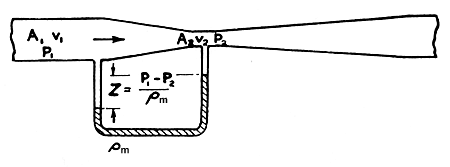taking the datum level at the
mouth of the tube and letting Z' be the height of the upper liquid
surface in the pipe above the
datum, and Z be the additional height of the fluid level in the
tube
above the upper liquid surface
in the pipe; Z' may be neglected if P1 is measured
at the upper
surface of the liquid in the
pipe, or if Z' is small compared with Z.
v2
= 0 as there is no flow in the tube.
P2 = 0 if atmospheric pressure is
taken as datum and if the top of the tube is open to the atmosphere.
Z1 = 0 because the datum level is
at the mouth of the tube.
The equation then
simplifies to
v12/2g
+ P1/r1
= (Z + Z')g »
Z.
(4.1)
This
analysis shows that the differential head on the manometer measures the
sum of the velocity head and the pressure head in the flowing liquid.
The
Pitot tube can be combined with a piezometer tube, and connected across
a common manometer as shown in Fig. 4.1(d).
The differential head across the manometer is the velocity head plus the
static head of the Pitot tube, less the static head of the piezometer
tube. In other words, the differential head measures directly the velocity
head of the flowing liquid or gas. This differential arrangement is known
as a Pitot-static tube and it is extensively used in
the measurement of flow velocities.
We can write for the Pitot-static tube:
Z = v2/2g
(4.2)
where Z is the differential
head measured in terms of the flowing fluid.
 EXAMPLE
4.2. Velocity of air in a duct EXAMPLE
4.2. Velocity of air in a duct
Air at 0°C is flowing through a duct in a chilling system. A Pitot-static
tube is inserted into the flow line and the differential pressure head,
measured in a micromanometer, is 0.8 mm of water. Calculate the velocity
of the air in the duct. The density of air at 0°C is 1.3 kg m-3.
From eqn. (4.2) we
have
Z = v12/2g
In
working with Pitot-static tubes, it is convenient to convert pressure
heads into equivalent heads of the flowing fluid, in this case air, using
the relationship:
r1Z1
= r2Z2
from eqn 3.3.
 |
Now
0.8 mm water |
=
0.8 x 10-3 x |
1000
|
|
|
|
1.3
|
| |
|
=
0.62 m of air |
|
| |
Also
v12
|
=
2Zg |
|
| |
|
=
2 x 0.62 x 9.81 |
|
=
12.16 m2s-2
Therefore
v1 = 3.5 m s-1
Another method of using pressure differentials to measure fluid flow rates
is used in Venturi and orifice meters. If flow is constricted,
there is a rise in velocity and a fall in static pressure in accordance
with Bernouilli's equation. Consider the system shown in Fig.
4.2.

Figure 4.2. Venturi meter
A gradual constriction
has been interposed in a pipe decreasing the area of flow from A1
to A2. If the fluid is assumed to be incompressible
and the respective velocities and static pressures are v1
and v2, and P1 and P2,
then we can write Bernouilli's equation (eqn.3.7) for the section of horizontal
pipe:
v12/2 + P1/r1
= v22/2+ P2/r2
Furthermore, from
the mass balance, eqn. (3.5)
A1v1 = A2v2
also, as it is the
same fluid
r1
= r2
= r
so that we have
v12/2 + P1/r
= (v1A1/A2)2/2
+ P2/r
v12 = [2(P2 -P1)/r]
x A22/(A22
-A12)
By joining the two sections of a pipe to a U-manometer, as shown in Fig.
4.2, the differential head
(P2 -P1)/r
can be measured directly. A manometric fluid of density rm
must be introduced, and the head measured is converted to the equivalent
head of the fluid flowing by the relationship:
(P2 -P1)/r
= gZrm
/r
and
so Z = (P2
-P1)/rm
g
If
A1 and A2 are measured, the velocity
in the pipe, v1, can be calculated. This device is
called a Venturi meter. In actual practice, energy losses do occur in
the pipe between the two measuring points and a coefficient C is introduced
to allow for this:
In
a properly designed Venturi meter, C lies between 0.95 and 1.0.
The
orifice meter operates on the same principle as the Venturi meter,
constricting the flow and measuring the corresponding static pressure
drop. Instead of a tapered tube, a plate with a hole in the centre is
inserted in the pipe to cause the pressure difference. The same equations
hold as for the Venturi meter; but in the case of the orifice meter the
coefficient, called the orifice discharge coefficient, is smaller. Values
are obtained from standard tables, for example British Standard Specification
1042. Orifices have much greater pressure losses than Venturi meters,
but they are easier to construct and to insert in pipes.
 Back
to the top Back
to the top |

